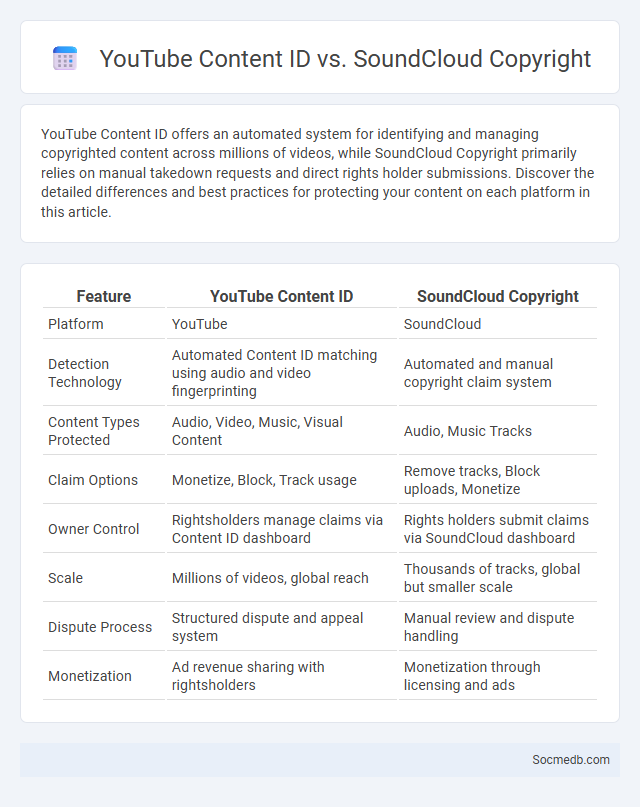
Photo illustration: YouTube Content ID vs SoundCloud Copyright
YouTube Content ID offers an automated system for identifying and managing copyrighted content across millions of videos, while SoundCloud Copyright primarily relies on manual takedown requests and direct rights holder submissions. Discover the detailed differences and best practices for protecting your content on each platform in this article.
Table of Comparison
| Feature | YouTube Content ID | SoundCloud Copyright |
|---|---|---|
| Platform | YouTube | SoundCloud |
| Detection Technology | Automated Content ID matching using audio and video fingerprinting | Automated and manual copyright claim system |
| Content Types Protected | Audio, Video, Music, Visual Content | Audio, Music Tracks |
| Claim Options | Monetize, Block, Track usage | Remove tracks, Block uploads, Monetize |
| Owner Control | Rightsholders manage claims via Content ID dashboard | Rights holders submit claims via SoundCloud dashboard |
| Scale | Millions of videos, global reach | Thousands of tracks, global but smaller scale |
| Dispute Process | Structured dispute and appeal system | Manual review and dispute handling |
| Monetization | Ad revenue sharing with rightsholders | Monetization through licensing and ads |
Overview of YouTube Content ID
YouTube Content ID is a powerful digital rights management system used by creators and copyright holders to identify and manage their original content uploaded to YouTube. This system scans videos for copyrighted material, allowing rights owners to monetize, track, or block unauthorized use of their content. Your ability to use Content ID effectively can protect your intellectual property and generate revenue through claimed videos.
How SoundCloud Handles Copyright Detection
SoundCloud utilizes advanced audio fingerprinting technology to detect copyrighted content uploaded by users, ensuring compliance with copyright laws. By matching uploaded tracks against a vast database of copyrighted material, the platform can quickly identify unauthorized use and take appropriate actions such as blocking or monetizing the content. You benefit from this proactive system as it helps maintain a safe environment for artists while respecting intellectual property rights.
Content ID Systems: Key Differences
Content ID systems on social media platforms differ primarily in their database size, matching algorithms, and user interface accessibility. YouTube's Content ID uses a vast database and automated fingerprinting technology to detect copyrighted material, while Facebook's Rights Manager integrates manual and automated processes tailored for video and audio content. TikTok employs AI-driven recognition with a focus on short-form videos and community reporting, reflecting varying approaches to copyright enforcement and content monetization across platforms.
Pros and Cons of YouTube Content ID
YouTube Content ID automates copyright management by scanning uploads and identifying copyrighted material, helping creators protect their intellectual property and earn revenue through monetization options. However, it also generates false claims and takedowns, potentially harming legitimate content and causing frustration for You when your videos are wrongly flagged. Balancing protection and fair use remains a challenge, emphasizing the need for improved accuracy and dispute resolution processes.
Pros and Cons of SoundCloud Copyright System
SoundCloud's copyright system provides robust content identification tools that help artists protect their intellectual property and claim rightful revenue from unauthorized use. However, the system sometimes struggles with false positives and inaccurate copyright claims, which can unfairly restrict legitimate user uploads and cause frustration. Efficient dispute resolution mechanisms and continual algorithm improvements are essential for balancing copyright enforcement and user rights on the platform.
Copyright Claim Process Comparison
Different social media platforms implement varying copyright claim processes to protect intellectual property rights. YouTube utilizes a Content ID system that automatically detects copyrighted material and allows rights holders to monetize, block, or track content. Facebook and Instagram use Rights Manager for manual and automated claim submissions, with options for removal, muting, or monetization, while TikTok provides a streamlined reporting tool for copyright infringement, emphasizing fast takedown actions.
User Experience: YouTube vs SoundCloud
YouTube offers a highly visual user experience with video content, interactive comments, and personalized recommendations based on viewing history, enhancing engagement for creators and viewers alike. SoundCloud prioritizes audio streaming with features like user-curated playlists, easy upload options for independent artists, and a focus on niche music communities that promote discovery of emerging talent. Your choice between YouTube and SoundCloud should consider whether you prefer a multimedia platform with extensive content variety or a specialized audio environment tailored for music sharing and collaboration.
Monetization and Revenue Impacts
Social media platforms generate substantial revenue through targeted advertising, subscription models, and influencer partnerships, making monetization a critical focus for sustained growth. Advanced data analytics enable precise audience segmentation, maximizing ad spend efficiency and driving higher returns on investment. Emerging features like in-app shopping and virtual events further expand revenue streams, enhancing profit potential across diverse user interactions.
Dispute and Appeal Mechanisms
Social media platforms implement dispute and appeal mechanisms to handle content moderation decisions, ensuring users can contest removals or bans. These mechanisms typically include automated reviews and human moderators to reassess flagged content based on platform policies and community guidelines. Effective appeal systems enhance transparency and user trust by providing clear processes and outcomes for content disputes.
Which Platform Offers Better Copyright Protection?
YouTube offers stronger copyright protection through its Content ID system, which automatically detects and manages copyrighted material uploaded by users. Facebook and Instagram provide copyright policies but rely heavily on user reports and manual reviews, leading to slower enforcement. For creators seeking robust copyright safeguards, YouTube remains the most reliable platform.
 socmedb.com
socmedb.com